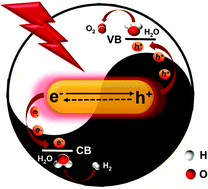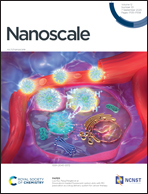Plasmon of Au nanorods activates metal–organic frameworks for both the hydrogen evolution reaction and oxygen evolution reaction†
Abstract
Electrocatalytic water splitting holds great promise for renewable energy conversion and storage systems. However, it usually suffers from sluggish kinetics, which greatly hinders its real application. Here, we demonstrate the utilization of the localized surface plasmon resonance (LSPR) of Au nanorods (AuNRs) to significantly improve the electroactivity of both the hydrogen evolution reaction (HER) and oxygen evolution reaction (OER) at Co-MOF nanosheets (Co-MOFNs) under different polarizations. Theoretical calculations suggest that the HER enhancement can be largely attributed to the injection of hot electrons from plasmonic AuNRs to Co-MOFN catalysts, which upraises the Fermi level of Co-MOFNs, increasing their reductive activity towards the HER. Regarding the promotion of the OER, it is indicated that the formed holes in Co-MOFNs should majorly locate on the surface oxygen atoms, which may also serve as active positions working jointly with neighboring Co atoms in oxidizing OH−. The plasmon enhanced HER and OER electrocatalysis could also be observed over AuNR/Ni-MOFN and AuNR/NiCo-MOFN catalysts, suggesting the generality of this strategy. This study highlights the possibility of accelerating both the HER and OER efficiency by AuNR plasmonic excitation and provides a new route towards the design of more efficient water splitting systems with the assistance of light energy.

- This article is part of the themed collection: 2020 Nanoscale HOT Article Collection


 Please wait while we load your content...
Please wait while we load your content...